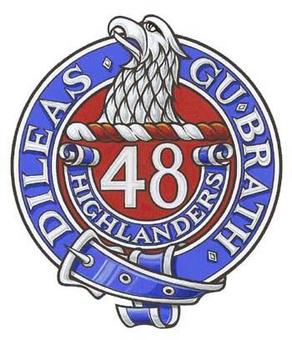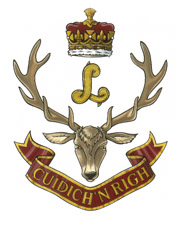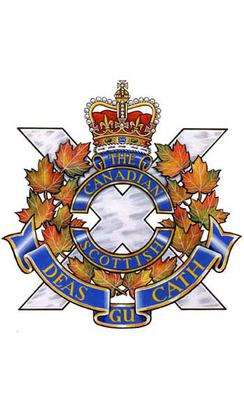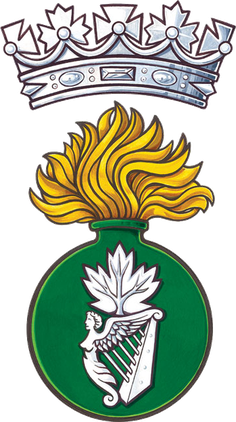Related Research Articles

The 48th Highlanders of Canada is a Canadian Forces Primary Reserve infantry regiment based in Toronto, Ontario, parading out of Moss Park Armoury. The regiment is part of 4th Canadian Division's 32 Canadian Brigade Group.
The Canadian Expeditionary Force (CEF) was the expeditionary field force of Canada during the First World War. It was formed on August 15, 1914 following Britain’s declaration of war on the German Empire, with an initial strength of one infantry division. The division subsequently fought at Ypres on the Western Front, with a newly raised second division reinforcing the committed units to form the Canadian Corps. The CEF and corps was eventually expanded to four infantry divisions, which were all committed to the fighting in France and Belgium along the Western Front. A fifth division was partially raised in 1917, but was broken up in 1918 and used as reinforcements following heavy casualties.

The Royal Hamilton Light Infantry (Wentworth Regiment) (RHLI) is a Primary Reserve infantry regiment of the Canadian Army, based at John Weir Foote VC Armoury in Hamilton, Ontario. The RHLI is part of 31 Canadian Brigade Group, which is part of 4th Canadian Division.

The Nova Scotia Highlanders is an infantry regiment in the primary reserve of the Canadian Army. It is part of 36 Canadian Brigade Group, 5th Canadian Division.

The Lorne Scots is a Primary Reserve infantry regiment of the Canadian Army. It is part of the 4th Canadian Division's 32 Canadian Brigade Group.

The Seaforth Highlanders of Canada is a Primary Reserve infantry regiment of the Canadian Army based in Vancouver, British Columbia. The regiment is subordinate to 39 Canadian Brigade Group, 3rd Canadian Division. Based at the Seaforth Armoury on Burrard Street in Vancouver, the regiment serves in both times of war and civil emergency, such as disaster relief after earthquakes or floods. It also contributes individual volunteers or "augmentees" to Canadian Forces operations around the world.

The Canadian Scottish Regiment (Princess Mary's) is a Primary Reserve infantry regiment of the Canadian Army based on Vancouver Island in British Columbia.
The 141st Battalion, CEF was a unit in the Canadian Expeditionary Force during the First World War.
The 218th Battalion, CEF, was a unit in the Canadian Expeditionary Force during the First World War. Based in Edmonton, Alberta, the unit began recruiting in early 1916 in that city.
The 226th Battalion, CEF was a unit in the Canadian Expeditionary Force during the First World War.

The 230th Battalion, CEF was a unit in the Canadian Expeditionary Force during the First World War.
The 248th Battalion, CEF was a unit in the Canadian Expeditionary Force during the First World War. Based in Owen Sound, Ontario, the unit began recruiting in the late summer of 1916 in Grey County. After sailing to England in June 1917, the battalion was absorbed into the 7th and 8th Reserve Battalions later that month. The 248th Battalion, CEF had one Officer Commanding: Lieut-Col. Joseph Hilliard Rorke.
The Peel and Dufferin Regiment was an infantry regiment of the Non-Permanent Active Militia of the Canadian Militia. First organized in 1866 as the 36th Peel Battalion of Infantry, the regiment was reorganized in 1900 as the 36th Peel Regiment. Following the First World War, the regiment was reorganized again in 1920 as The Peel Regiment and for the final time in 1923 as The Peel and Dufferin Regiment. In 1936, the regiment was Amalgamated with The Lorne Rifles (Scottish) to form The Lorne Scots.

The 16th Battalion, CEF was a unit of the First World War Canadian Expeditionary Force. It was organized at Valcartier on 2 September 1914 in response to the Great War and was composed of recruits from the 91st Regiment Canadian Highlanders, the 79th Cameron Highlanders of Canada, the 72nd Regiment "Seaforth Highlanders of Canada", and the 50th Regiment "Highlanders".
231st may refer to:

The 5th Battalion, CEF, known as "Tuxford's Dandys," was an infantry battalion of the Canadian Expeditionary Force during the Great War.

The Irish Fusiliers of Canada (The Vancouver Regiment) was an infantry regiment of the Canadian Army. It was placed on the Supplementary Order of Battle in 1965. In 2002, it was taken off the Supplementary Order of Battle and amalgamated with The British Columbia Regiment (Duke of Connaught's Own).
The 65th Battalion (Saskatchewan), CEF was an infantry battalion of the Canadian Expeditionary Force during the Great War. The 65th Battalion was authorized on 20 April 1915 and embarked for Great Britain on 18 June 1916. Its personnel were absorbed by the 44th Battalion (Manitoba), CEF, 46th Battalion, CEF, 54th Battalion (Kootenay), CEF and 72nd Battalion, CEF of the 4th Canadian Division on 30 June 1916. The battalion was disbanded on 12 October 1917.

The 72nd Battalion, CEF was an infantry battalion of the Canadian Expeditionary Force during World War I, and recruited throughout the province of British Columbia.
The Middlesex and Huron Regiment was an infantry regiment of the Non-Permanent Active Militia of the Canadian Militia. It was formed in 1936, as a result of the Amalgamation of The Middlesex Light Infantry and The Huron Regiment. In 1946, the regiment was disbanded.
References
- ↑ "231st Battalion, Hastings Park - RBCM Archives". search-bcarchives.royalbcmuseum.bc.ca. Retrieved 1 March 2023.
- ↑ Appendix to General Order No. 110 of 1929, p. 38
- Meek, John F. Over the Top! The Canadian Infantry in the First World War. Orangeville, Ont.: The Author, 1971.